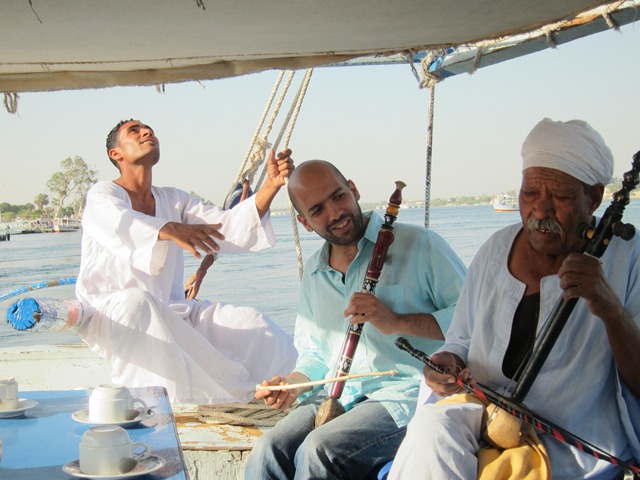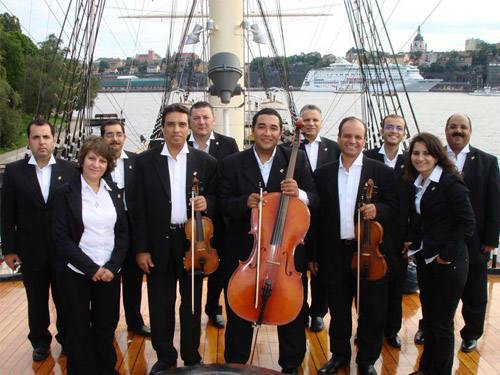Most Egyptians have never heard Ancient Egyptian music, a 5,000-year-old art form that has nearly disappeared. But in 2000 a small group of musicians and educators got together in an attempt to revive this music and make it available to students, performers and listeners.
There are only two places in which Ancient Egyptian music is presently taught–Helwan University's College of Musical Education and the Maqam Recording and Rehearsal Studio. The university has been offering courses, diplomas and degrees in Ancient Egyptian music theory and history since 2000, while Maqam studio has been offering courses in theory and performance since November 2010.
Mahmoud al-Qammari, one of just two students studying Ancient Egyptian music at Maqam studio said, "This music may be ancient, but it's new to me." A guitarist, al-Qammari is naturally interested in string instruments like the Ancient Egyptian harp. He has been attending courses on the harp for the past two months.
Professional harpist Sylvia Mohamad, who teaches the Ancient Egyptian harp every Saturday at Maqam, was introduced to this ancient instrument while studying harp at the Cairo Music Conservatory. "There is a band named Ahfad el-Fara'ana (Grandchildren of the Pharaohs) which performs at local venues, such as the Sawy Culture Wheel. Yet currently there is only a limited interest in rediscovering this form of music."
Mohamad explained that the Ancient Egyptian harp evolved from the hunting bow during the Old Kingdom's fourth dynasty. "It evolved from a four stringed instrument, to tens strings, to 21 strings." She explained that there is no surviving notation or sheet music available from which to study this form of harp playing. "From Ancient Egyptian murals we know that musicians had conductors, and that these conductors had symbols or arm gestures corresponding to each note or chord."
According to Mohamad the harp was the favored instrument of the day. "This instrument was performed for the entertainment of royals and notables, while also being used for ceremonial, religious and funerary music."
Other popular Ancient Egyptian instruments included wooden clappers and hand-clapping, along with the predecessors of the doff (a bassy tambourine-like drum), the naiy (a reed flute,) the lyre, and the oud (a fretless lute), along with vocals. Maqam Studio offers weekly courses on his harp, along with courses for the ginginty, a three-stringed lute-like instrument; the benet, which is nearly identical to the naiy; and ancient percussion instruments. Lessons in the kinar, an instrument resembling a lyre whose local descendants are the tamboura and simsimia, are not yet available.
Music professor Khairy al-Malt, the founder of the National Project for the Revival of Ancient Egyptian Music, told Al-Masry Al-Youm that, in addition to providing theoretical and historical education, "the project has made use of three academics from the College of Applied Arts and three craftsmen for the manufacturing of Ancient Egyptian instruments." These instruments are reproduced according to their original measurements and tones and use materials as close as possible to those used at the time. "The band Ahfad al-Fara'ana has assisted in making this ancient music available to local listeners," added al-Malt.
Ancient Egyptian music utilizes pentatonic, diatonic and minor scales, along with Middle Eastern scales based on 3/4th tones. According to Ahmed Salah, a professional oud player, ginginty instructor and owner of Maqam Studio, "We know from ancient murals that this form of music reached a point where they had developed dual harmonies, and perhaps more, since conductors are depicted leading musicians in two different lines of harmony."
"I've always been attracted to ethnomusicology. This interest of mine drew me to study Ancient Egyptian music and to specializing in the ginginty," said Salah, adding "there is not much local interest in Ancient Egyptian music; foreigners, more than Egyptians, seem to be interested in this form of music."
Ancient Egyptian music may have originated as early as 3000 BCE, with hand-clapping, singing, percussion instruments resembling tambourines, and the benet. Salah explained that the benet (and by descent, the naiy) may have originated in the homes of ancient Egypt, which used reeds or bamboo for roofing. "The wind blowing over this roof and through these hollow plants would have created musical sounds. The naiy, panpipes and flutes, all originated with these plants."
Music from the days of the Pharaohs was not written in notation until the arrival of the Greeks in Egypt. However, according to Salah, "this form of old Greek notation is inaccurate, and it can be read and interpreted in a number of different ways." The Coptic Church has retained some Ancient Egyptian music in its liturgical music and hymns; although its language and religious message are different from those used in Ancient Egypt, "a hymn like 'Golgotha,' which is still sung and recited in Coptic churches, is taken directly from Ancient Egyptian music."
Salah concluded that "there are presently only about 15 people who are capable of playing this music" on replicas of traditional Ancient Egyptian instruments. But there is increasing exposure to Ancient Egyptian music due to recitals, performances, study courses, websites and media coverage.
"It's popularity may be growing, but not rapidly. Each year perhaps five musicians will learn to perform this music."



